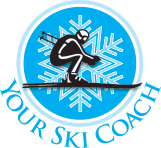Is It Really OK TO SKID?
I Thought I Should Carve!
Is It Really OK TO SKID?
I Thought I Should Carve!

Really this is a terminology of turns thing I think. I thought there were really 3 types of turn:
1. Plough, with plough-parallel as a midway step onwards to...
2. Parallel, which when executed properly are
3. Carved
I am a bit confused over the skidding issue - I thought it was what people do who can't edge enough to carve the turns neatly but who've moved on from ploughing. And kind of confirming that in my mind, near the start you say that skidding around a turn is to be avoided and I assumed that narrow track skidded turns were better and closer to carving than wide track but still not what's really wanted.
Then a bit later on you advise skidding as a specific technique...
I understand about using a combination of different radii & angles and can see that the wide track turns are sort of a steered sideslip which would be a good confidence building exercise for me.
Heather
Your Ski Coach Home> Ask The Coach> Balance> Is it OK to skid?
A simple way to sort this all out in your mind is to think of parallel turns in two categories; Steered and Carved. Neither are right or wrong, they just represent different tools you can use to accomplish different objectives as you ski.
Steering is the first skill set you need to master. Have a read of this article to see why:
http://www.yourskicoach.com/YourSkiCoach/A_Revival_of_the_Steered_Turn.html
Many find learning a full spectrum of steering skills more challenging than learning to carve. It certainly provides you with more turn shape and speed control options than carving does. While carving provides and exhilarating ride down the mountain, good steering skills will get you down any slope in comfort and safety. Steering also provides a safety valve when you need to quickly change direction or dump speed when carving.
Skid angle simply refers to how sideways your skis are to your direction of travel when steering. It's an excellent speed management tool. The bigger your skid angle, the slower you will travel through whatever turn shape you choose. To be able to use different skid angles through the same turn shape is a skill that needs to be worked on to be perfected. Once you have it, any trail can be skied comfortably and confidently, at any speed you desire. The same can't be said for carving.
I teach these steering skills in my Basic Edging DVD. In that DVD I don't say skidding should be avoided. What I try to eliminate from peoples skiing is the pivot at the beginning of the turn. A great many recreational skiers have an aggressive tail toss that they use at the beginning of every turn. It's a defensive move designed to get their skis out of the falline as quickly as possible so they don't have to experience that intimidating acceleration period that happens through the top half of a turn when a pivot is not used.
We strive to eliminate that default pivot move because it's a labor intensive thing to do, and it interrupts a smooth flow from turn to turn. The fear that acceleration produces during a non pivoted turn is a result of feeling it can't be controlled once it happens. Through the development of solid turn shape and skid angle skills while steering, those fears go away, and the skier can come to enjoy that top of the turn acceleration, knowing they can reduce it through the bottom half of the turn to what ever degree they desire. That acceleration is one of the great thrills of skiing, and employing nice round (non pivoted) turn shapes provides a very pleasant feeling of fluidity as you link a series of effortless turns down the mountain.
Thanks Rick
I have had a long chat with Charlotte tonight.
We came to the conclusion that my confusion concerning skidded turns/parallel/carved is a terminology thing - she said what is referred to as a "skidded turn" isn't necessarily the same both sides of the pond! In europe (and by implication by lots of Snowheads) it's likely to mean that undesirable habit of "tail tossing" (skidding them!) to initiate a turn. I now realise that is entirely different from what's going on in a steered turn, which I had not really appreciated before. I can now see there is a difference between a quite forceful skid into a turn, where the turns are like a series of "hockey stops" and sequence of gradual steered turns. I assume that the style where people pick up and reposition their inside ski as they turn is not a good habit and a hangover from straight ski days though of course it must mean that their weight's properly off of it!
That has been a very important thing to pick up I think!
Heather
